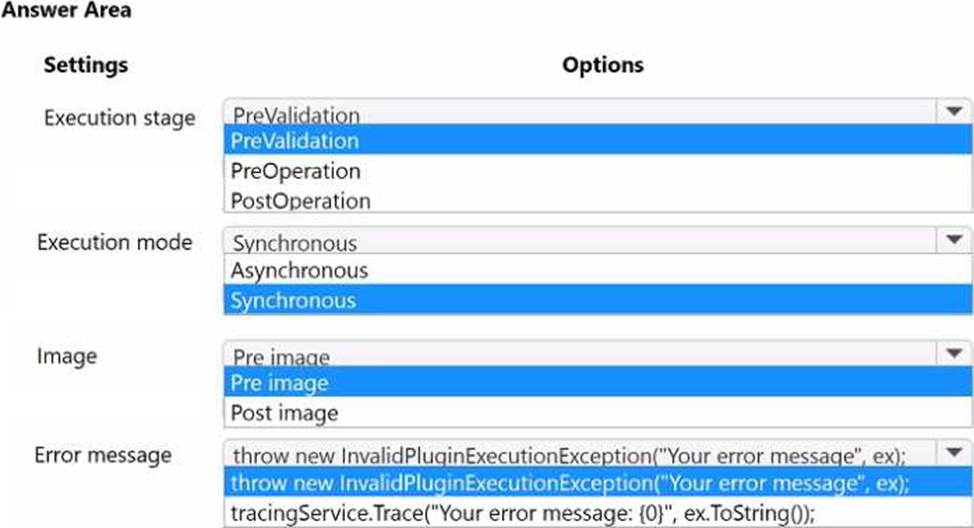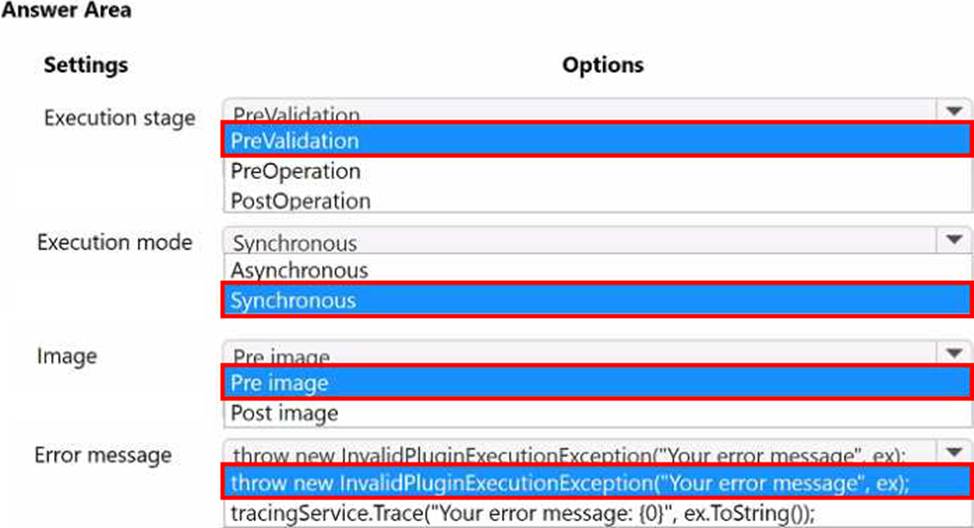Practice Free PL-400 Exam Online Questions
HOTSPOT
You need to synchronize pharmacy names and ensure that Dynamics 365 Sales data propagates correctly to the Cerner system.
What should you do? To answer, select the appropriate options in the answer area. NOTE: Each correct selection is worth one point.
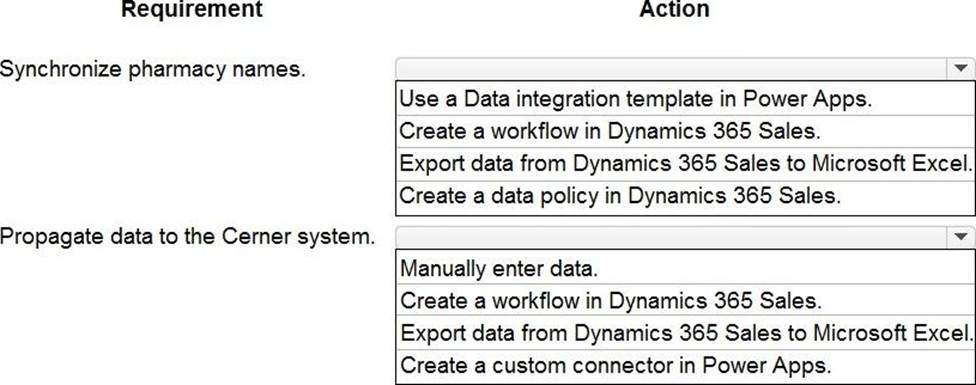
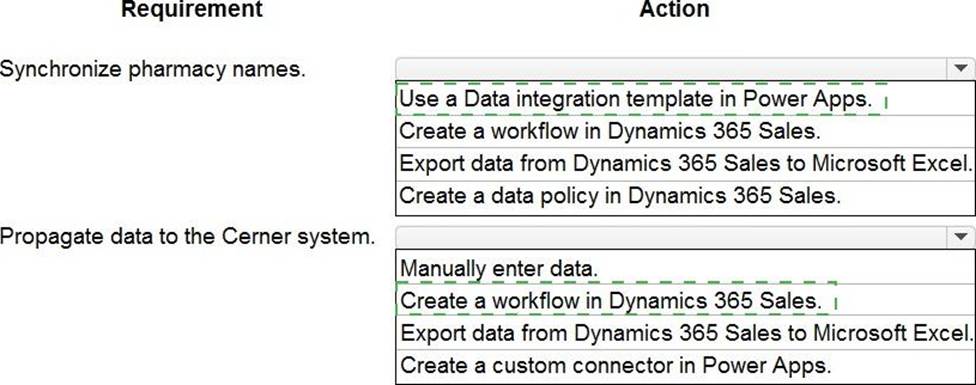
Explanation:
Box 1: Use a Data Integration template in Power Apps.
Ensure that the names of the pharmacies are synced between the accounting and the customer management systems.
Note: The Data Integrator (for Admins) is a point-to-point integration service used to integrate data into Dataverse. It supports integrating data between Finance and Operations apps and Dataverse. It also supports integrating data into Finance and Operations apps and Dynamics 365 Sales.
The Data Integrator (for Admins) consists of the Data Integration platform, out-of-the-box templates provided by our application teams (for example, Finance and Operations apps and Dynamics 365 Sales) and custom templates created by our customers and partners.
Box 2: Create a workflow in Dynamics 365 Sales.
Account numbers should be entered automatically into the pharmaceutical system that is in a Cerner database and kept in sync.
Note: Start When: Use the options in this section to specify when a workflow should start automatically. You can configure a real-time workflow to be run before certain events. This is a very powerful capability because the workflow can stop the action before it occurs.
The options are:
✑ Record is created
✑ Record status changes
✑ Record is assigned
✑ Record fields change
✑ Record is deleted
Reference: https://docs.microsoft.com/en-us/power-platform/admin/data-integrator
DRAG DROP
You are developing a Power Platform app for a school. The school plans to use the app to gather information about classes and students.
You must design a plug-in for the app. You must store data about students in the Contacts table and store data about classes in a custom table.
You need to select the stage in the event pipeline for each function.
Which stages should you use? To answer, drag the appropriate plug-in stages to the correct functions. Each plug-in stage may be used once, more than once, or not at all. You may need to drag the split bar between panes or scroll to view content. NOTE: Each correct selection is worth one point.


Explanation:
Box 1: PreValidation
For the initial operation, this stage will occur before the main system operation.
This provides an opportunity to include logic to cancel the operation before the database transaction.
Box 2: PreOperation
Occurs before the main system operation and within the database transaction.
If you want to change any values for an entity included in the message, you should do it here.
Avoid cancelling an operation here. Canceling will trigger a rollback of the transaction and have significant performance impact.
Box 3: PostOperation
Occurs after the main system operation and within the database transaction.
Use this stage to modify any properties of the message before it is returned to the caller.
Reference: https://docs.microsoft.com/en-us/powerapps/developer/data-platform/event-framework
DRAG DROP
You create solutions in a development environment and export the solution for testing by various departments in your organization. Power users in each department control the testing environments.
You must display department-specific wording at the beginning of any custom notifications that are displayed in testing environments.
You need to package solutions to ensure that the power users can customize the notification content.
Which three actions should you perform in sequence inside a solution? To answer, move the appropriate actions from the list of actions to the answer area and arrange them in the correct order.

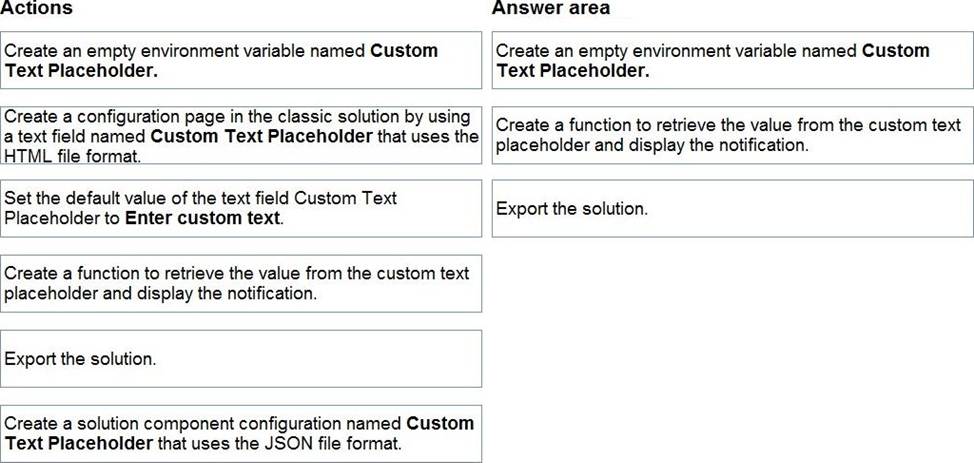
Explanation:
Step 1: Create an empty environment variable named Custom Text Placeholder.
Applications often require different configuration settings or input parameters when deployed to different environments. Environment variables store the parameter keys and values, which then serve as input to various other application objects. Separating the parameters from the consuming objects allows you to change the values within the same environment or when you migrate solutions to other environments.
Step 2: Create a function to retrieve the value from the custom text placeholder and display the notification.
Step 3: Export the solution
You can manually export solutions. Microsoft recommends that you create an unmanaged solution to use for exporting your customizations, and then export your customizations periodically so that you have a backup in case anything happens.
Reference:
https://docs.microsoft.com/en-us/powerapps/maker/data-platform/environmentvariables
https://docs.microsoft.com/en-us/powerapps/maker/data-platform/export-solutions
DRAG DROP
A company plans to deploy an Azure Function that connects to Dataverse on a defined schedule to bulk-update Account data.
Corporate policy discourages password-based authentication if other viable options exist.
You need to implement the function app.
Which three actions should you perform in sequence? To answer, move the appropriate actions from the list of actions to the answer area and arrange them in the correct order.
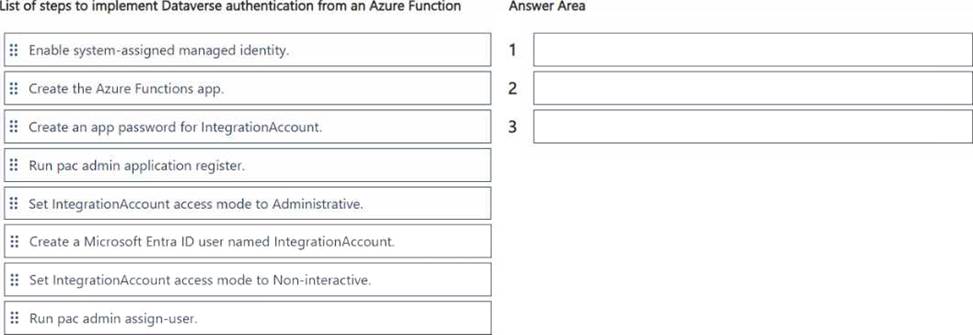
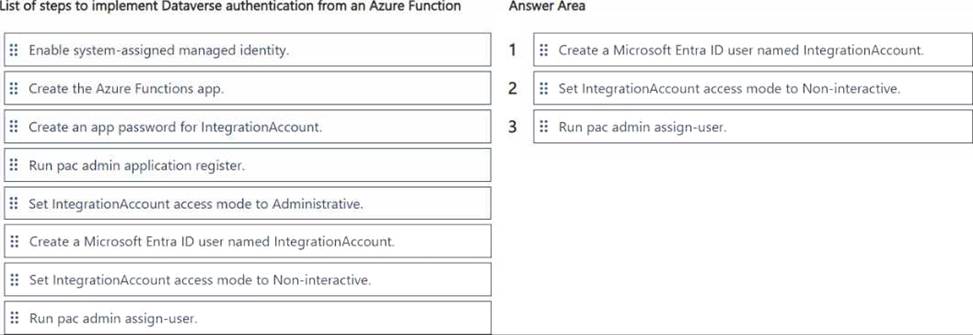
An organization uses Dynamics 365 Sales. The organization has accounting and customer service departments.
You must restrict users in customer service from being able to change the value of the balance field on the Contact records. The accounting team must be the only team able to edit this field. You need to create the appropriate solution without any customizations.
What should you do first?
- A . Enable field security for the balance field and grant the customer service team read and update permissions.
- B . Create a customer service form and role and make the balance field read-only.
- C . Enable field security for the balance field and grant the accounting team read permissions.
- D . Enable field security for the balance field and grant the customer service team read permissions.
C
Explanation:
In Dynamics 365 Customer Engagement (on-premises), you use field-level security to restrict access to high business impact fields to specific users and teams. For example, you use this to enable only certain users to read or update the credit score for a customer.
Reference: https://docs.microsoft.com/en-us/dynamics365/customerengagement/on-premises/developer/security-dev/use-field-security-control-access-field-values
HOTSPOT
You work for a staffing company that helps employees fill temporary jobs. Available temporary jobs are categorized and listed on a secure area of the company’s website.
The company wants to eliminate manual work that relates to job and candidate management. The company plans to invite employers with available jobs and job candidates to view jobs by sending personalized invitations.
The company identifies the following requirements:
✑ Human resources team members from the staffing company must be able to access the jobs listing and post available positions.
✑ Employers seeking temporary employees must also be able to access the jobs listing and post available positions.
✑ Approved job candidates must be notified about new positions for which they are qualified.
✑ Approved job candidate must have an option to accept a job assignment directly from a notification.
You need to perform a gap analysis against the features and capabilities of the Power Platform.
Which features should you implement? To answer, select the appropriate options in the answer area. NOTE: Each correct selection is worth one point.
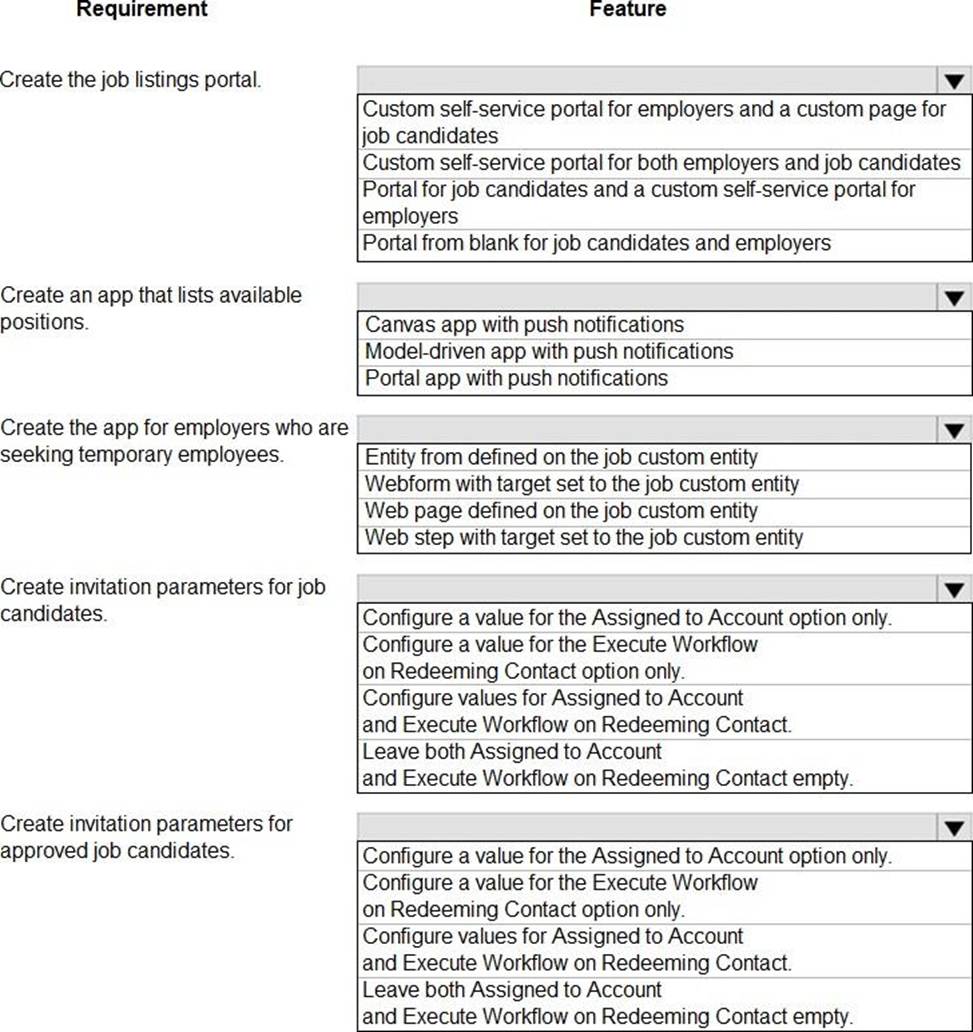
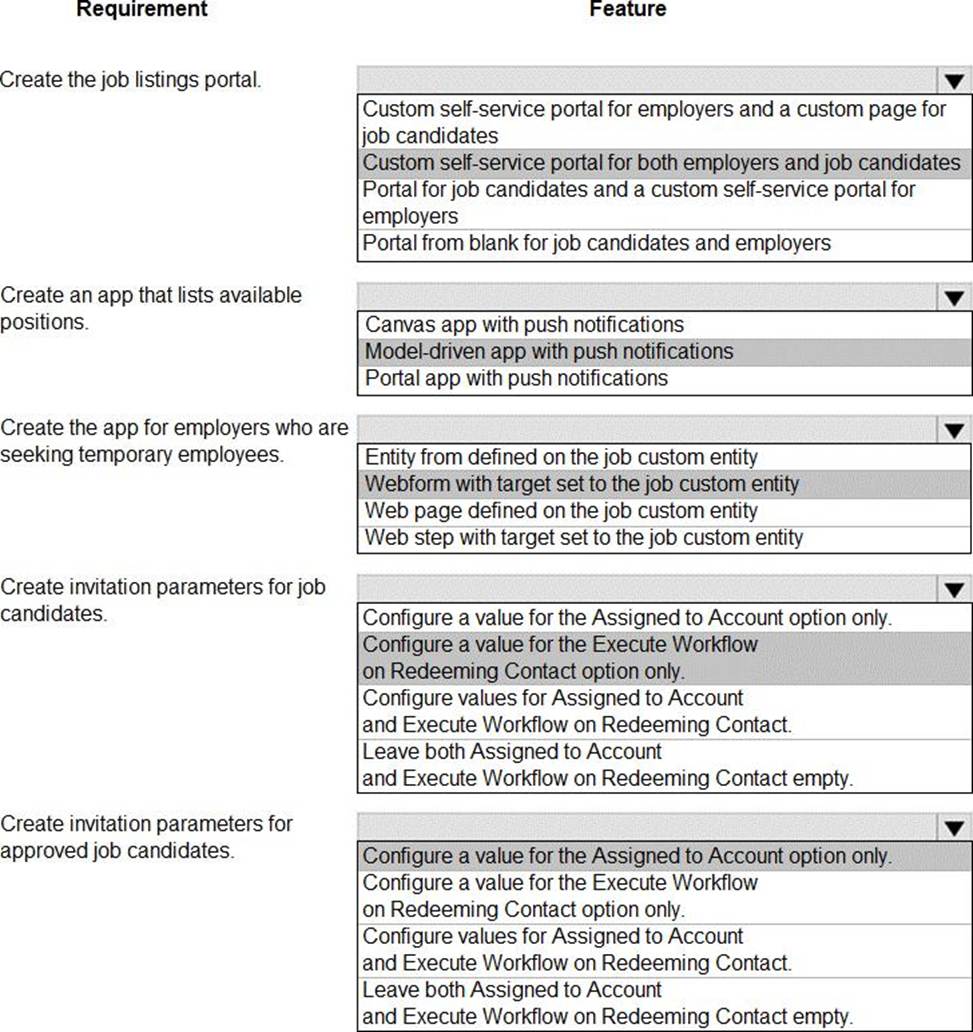
Explanation:
Box 1: Custom self-service portal for both employers and job candidates
If you select an environment that contains customer engagement, you can create the following portals:
Customer self-service portal: A customer self-service portal enables customers to access self-service knowledge, support resources, view the progress of their cases, and provide feedback.
Partner portal: A partner portal allows every organization with resellers, distributors, suppliers, or partners to have real-time access to every stage of shared activities.
Employee self-service portal: An employee self-service portal creates an efficient and well-informed workforce by streamlining common tasks and empowering every employee with a definitive source of knowledge.
Box 2: Model-driven app with push notifications
Compared to canvas apps, model-driven apps in PowerApps are based on underlying data ― specifically, the data stored in Common Data Service (CDS).
Box 3: Webform with target set to the job custom entity
Box 4: Configure a value for the Execute Workflow on Redeeming Contact option only.
Execute Workflow on Redeeming Contact: A workflow process to be executed when the invite is redeemed. The workflow will be passed the redeeming contact as the primary entity.
Box 5: Configure the value for the Assigned to Account option only.
Assign to Account: An account record to be associated as the redeeming contact’s parent customer when the invite is redeemed.
Reference:
https://docs.microsoft.com/en-us/powerapps/maker/portals/portal-templates
https://global.hitachi-solutions.com/blog/canvas-vs-model-driven-apps
https://docs.microsoft.com/en-us/powerapps/maker/portals/configure/invite-contacts#invitation-attributes
You are developing a model-driven app using JavaScript.
You need to configure the app to display a dialog box when a form is opened or when a grid on a form is sorted.
What should you use?
- A . Grid OnSave
- B . Grid OnRecordSelect
- C . Grid OnChange
- D . Subgrid OnLoad
HOTSPOT
You are creating a package for a Power Platform solution. The package will include custom code and sample data.
The package must include all files that need to be installed.
You need to configure the package.
Which setting should you use? To answer, select the appropriate options in the answer area. NOTE: Each correct selection is worth one point.
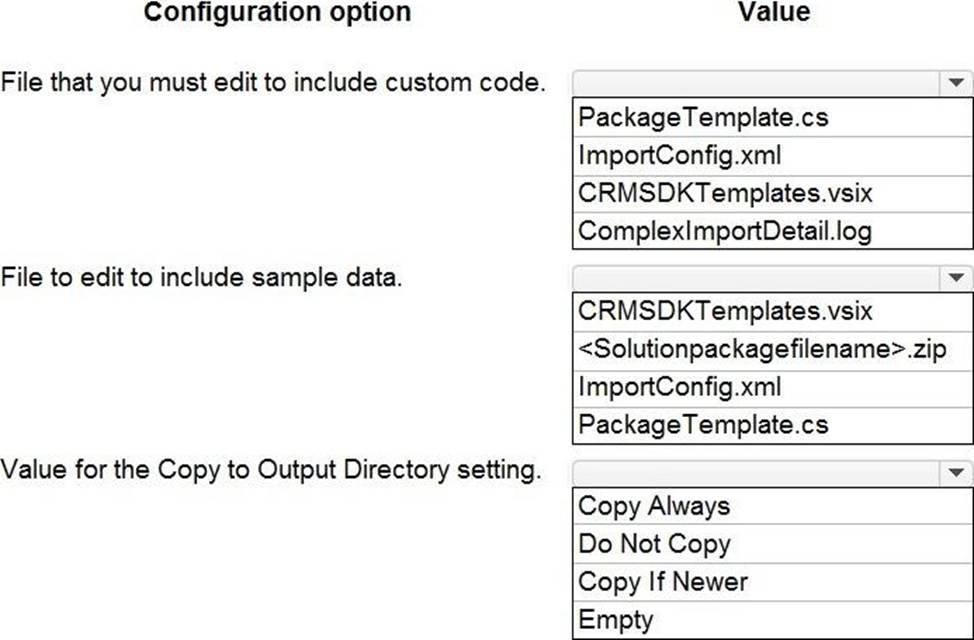
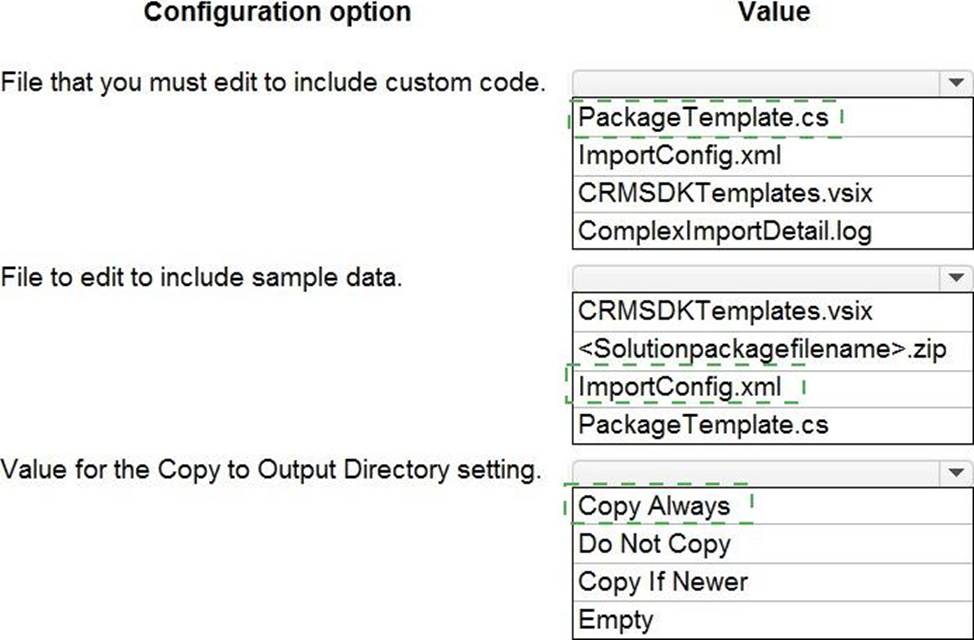
Explanation:
Box 1: PackageTemplate.cs
Define custom code for your package in the PackageTemplate.cs file.
Box 2: ImportConfig.xml
The sample data and some flat files for solutions specified in the ImportConfig.xml file are imported before the solution import completes.
Box 3: Copy Always
Set the Copy to Output Directory value to Copy Always. This ensures that your file is available in the generated package.
Reference: https://docs.microsoft.com/en-us/power-platform/alm/package-deployer-tool
HOTSPOT
A delivery service uses a canvas app to track and deliver packages. The app uses SQL Server as a data store.
The database includes the following tables:

The app includes the following code to save all required information. (Line numbers are included for reference only.)
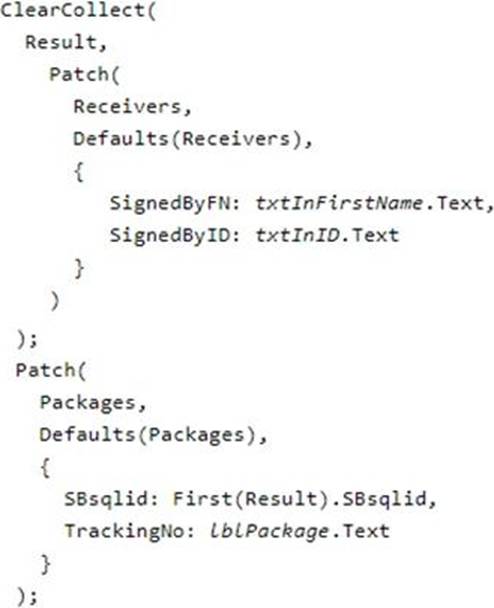
For each of the following statements, select Yes if the statement is true. Otherwise, select No. NOTE: Each correct selection is worth one point.
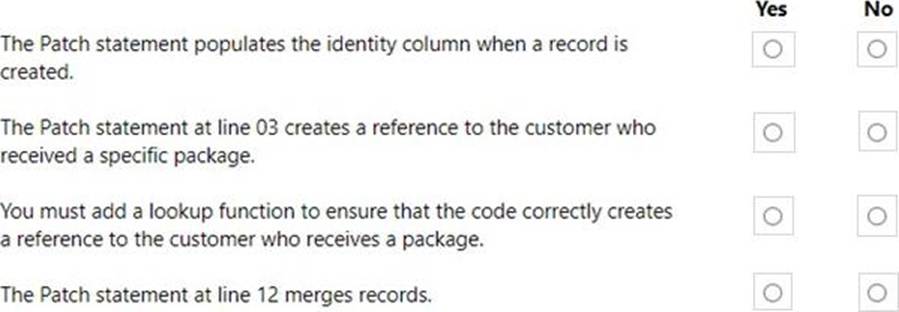
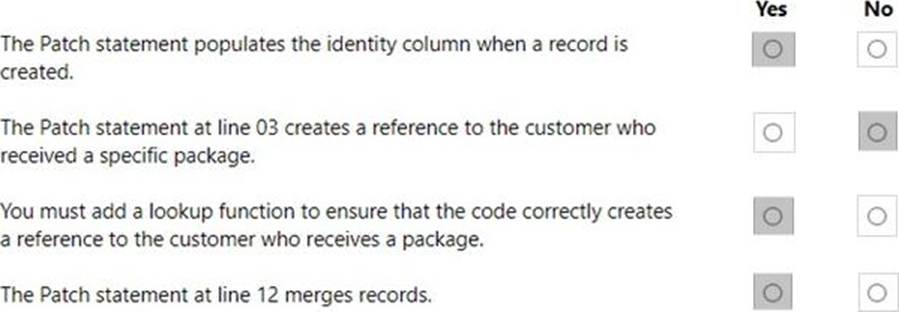
Explanation:
The ClearCollect function deletes all the records from a collection.
Syntax: ClearCollect( Collection, Item, … )
Collection C Required. The collection that you want to clear and then add data to.
Item(s) – Required. One or more records or tables to add to the data source.
Box 1: Yes
The Patch function in Power Apps modifies or creates one or more records in a data source, or merges records outside of a data source. Use Patch with the Defaults function to create records.
Box 2: No
The return value of Patch is the record that you modified or created. If you created a record, the return value may include properties that the data source generated automatically. However, the return value doesn’t provide a value for fields of a related table.
For example, you use Set(MyAccount, Patch(Accounts, First(Account), ‘Account Name’: "Example name"); and then MyAccount.’Primary Contact’.’Full Name’. You can’t yield a full name in this case. Instead, to access the fields of a related table, use a separate lookup such as:
LookUp(Accounts, Account = MyAccount.Account).’Primary Contact’.’Full Name
Box 3: Yes
Box 4: Yes
Merge records outside of a data source.
Specify two or more records that you want to merge. Records are processed in the order from the beginning of the argument list to the end, with later property values overriding earlier ones.
Patch returns the merged record and doesn’t modify its arguments or records in any data sources.
Reference: https://docs.microsoft.com/en-us/powerapps/maker/canvas-apps/functions/function-clear-collect-clearcollect
HOTSPOT
A manufacturing company takes online orders.
The company requires automatic validation of order changes.
Requirements are as follows:
• If validation is successful, the order changes must be submitted.
• If exceptions are encountered, a message must be shown to the customer and the order changes must not be submitted.
You need to set up and deploy a plug-in that encapsulates the rules.
Which options should you use? To answer, select the appropriate options in the answer area. NOTE: Each correct selection is worth one point.
